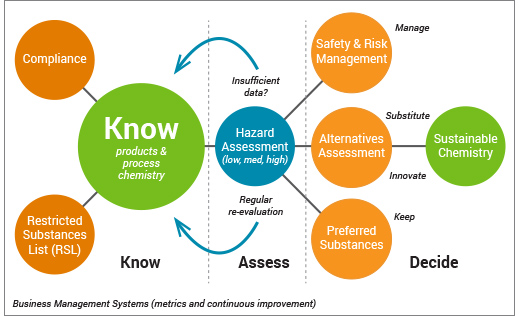The Chemicals Management Module is a strategic roadmap companies can adopt to better manage the chemicals used to create their products.
Originally written by members of the Outdoor Industry Association (OIA), it has now been integrated into the Higg Index, a suite of sustainability assessment tools designed to improve the overall sustainability efforts in the footwear and apparel sector.
The Chemical Management Module enables companies to benchmark, establish, maintain and improve chemicals management processes as part of an overall management system. I like this strategic guide because it provides direction for any company (does not have to be from the Outdoor Industry or even the apparel industry) that wants to start the journey of managing chemicals used to create their products.
The module, with its accompanying documents are available to download from the OIA website. It is organized into seven primary objectives that form the building blocks of a robust chemicals management strategy. Chemical data is assessed through a variety of means to create actionable information to support decision-making.
There is a corresponding instruction guide for Retailers, Brands, Manufacturers and Chemical Suppliers and a know-how toolkit that provides a wealth of information to help users as they start on this important journey of inherently safer chemicals in products, manufactured in cleaner supply chains.
Objectives of the Chemical Management Module
- Regulatory Awareness and Compliance. Know and ensure compliance with all chemicals management related regulations.
- Process and Product Chemicals Knowledge. Know, disclose and verify all chemicals used in manufacturing and/or residing in the final product.
- Chemical Hazard Assessment. Assess chemicals to understand their potential hazards to human health and the environment. Determine if a chemical has a low, medium or high hazard profile or if there is not enough data available. Based on the results of the assessment, the chemical can follow 3 different paths.
- Restricted Substances and Substances of Concern. Chemicals should be targeted for substitution. Create, communicate and ensure compliance with a Restricted Substance List (RSL). The RSL should contain chemicals that are actively managed and may contain chemicals for controlled use, targeted for elimination, banned or regulated.
- Chemical Safety and Risk Assessment. Chemicals should be carefully managed. Use the results from the chemical hazard assessment to conduct an exposure and risk assessment if necessary. Determine appropriate process controls needed to manage the chemical use and fate to ensure the safe use of chemicals in the workplace, the safe discharge to the environment and the safe use in the final product.
- Safer Alternative Assessment and Preferred Substances. Chemicals have inherently lower hazard profiles. Conduct a chemical alternative assessment for selected chemicals of concern to identify a safer alternative and to avoid a regrettable substitution. Use alternative assessments to create a preferred chemicals list. Communicate and ensure compliance with a preferred substance list.
- Sustainable Chemistry Innovation and Continuous Improvement. Advance the market for and use of viable alternatives to hazardous chemicals by communicating, implementing and rewarding sustainable chemistry innovation.
What are the impacts to your business?
Questions to consider:
- Do you have a chemical management strategy in place?
- Do you think it is a good idea to do an assessment using the CMM?
- Are you thinking about ways to get beyond regulatory compliance?
For help with any issue associated with chemicals, contact Amanda Cattermole at (415) 412 8406 or Amanda@cattermoleconsulting.com. We can help you develop powerful solutions to protect your company and brand reputation that also result in safer products manufactured in cleaner supply chains.
Tips and Insights is published bi-monthly and contains information to help you make informed chemical management decisions. Each post highlights a particular topic and includes questions you may want to consider for your business.


